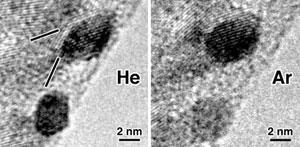Changing carrier gas during nanotube production dramatically improves ratio of metallic tubes
Adding helium gas when making carbon nanotubes encourages many more of them to grow in the useful metallic form, US researchers have found. Using this process, nanotubes can be made in large amounts with up to 91 per cent in the highly conducting metallic form. This research should provide access to greatly enhanced samples of nanotubes, for applications from power generation to futuristic circuitry.
Carbon nanotubes are essentially rolled up sheets of carbon atoms - but they can roll up in different ways, which dramatically affects their properties. Some are highly conducting - termed metallic - and others are semiconducting, and typical growing conditions produces a mixture of the two. The metallic tubes are prized for their ’ballistic conduction’, which means they can transmit large amounts of electricity without losing any as heat.
’Typically, growing nanotubes results in around 30 per cent metallic and 70 per cent semiconducting,’ says Avetik Harutyunyan, lead author on the research at Honda’s Research Institute in Ohio. Although recent advances have optimised the growth of semiconducting tubes to over 90 per cent, he says, increasing the number of metallic tubes in the mixture has been challenging.
Now, Harutyunyan’s team have discovered how to do this by varying the gas mix used in production. A common way to grow nanotubes is from a mixture of iron nanoparticles and methane gas. Under vacuum and at around 700-800?C, the iron acts as a catalyst - removing carbon from the methane until it becomes saturated. At this point, nanotubes begin to precipitate.
’Recently, we found that by adding argon or helium to the chamber we could change the ratio of metallic to semiconducting tubes,’ Harutyunyan says. After tweaking the mix, the team were able to produce tubes that were 91 per cent metallic, and are confident that the number can be increased further.
To discover how the noble gases affect the reaction, the Honda scientists teamed with researchers at the University of Louisville, Kentucky, and at Purdue University, Indiana. These groups confirmed that the metallic nanotubes were being formed, and used transmission electron microscopy (TEM) to study what was taking place during the reaction.

’The results show that the atomic structure of the catalyst nanoparticle can be controlled by the ambient carrier gas,’ says Eric Stach, who led the Purdue team. Stach found that when helium is used in place of argon, the iron particles become more regular in size and have flat areas on their surface. ’The helium and the presence of these facets, together with the size of the iron particles, appears to be what allows the creation of the metallic nanotubes,’ Stach explains.
Iris Nandhakumar, an expert in carbon nanotubes at the University of Southampton, UK, is excited by the research. ’The best thing about this work is that it’s easy to implement. Changing the gas mix should be simple, so other people making nanotubes could increase their control over which nanotubes they are growing.’
Lewis Brindley
References
A Harutyunyan et alScience, 2009, DOI: 10.1126/science.1177599






No comments yet